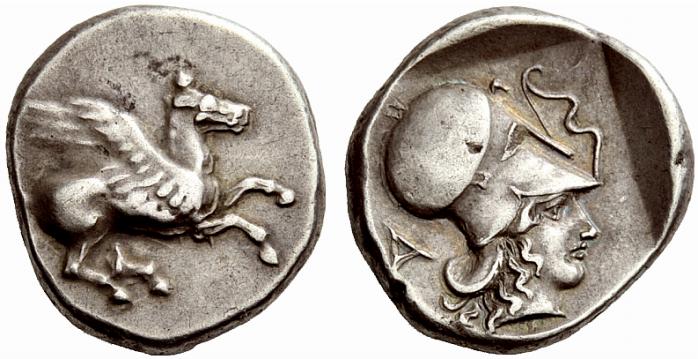AC 177 - Ambracia, silver, staters (485-475 BCE)
From SILVER
485 BCE - 475 BCE Silver 2,430 kg
Description
| ObverseInscription or printing placed on the obverse.: | Pegasus flying r. |
| ReverseInscription or printing placed on the reverse.: | Helmeted head of Athena r., behind, A and before, bow |
Mint and issuing power
| MintIdentifies the place of manufacture or issue of a numismatic object.: | Ambracia | Ancient regionAncient region.: | Epirus | Modern countryModern country: Greece | AuthorityIdentifies the issuing power. The authority can be "pretended" when the name or the portrait of X is on the coin but he/she was not the issuing power. It can also be "uncertain" when there is no mention of X on the coin but he/she was the issuing power according to the historical sources: |
Chronology
| FromIdentifies the initial date in a range assigned in a numismatic context. | 485 BCE | toIdentifies the final date in a range assigned in a numismatic context.. | 475 BCE | PeriodTime period of the numismatic object.: Archaic and Classical |
Physical description
| MetalThe physical material (usually metal) from which an object is made.: | Silver |
Median weightMedian of the weights of numismatic objects (in grams). in grams | 8.60 | DenominationTerm indicating the value of a numismatic object. Examples: tetradrachm, chalkous, denarius.: | stater |
StandardStandard.: |
Image

AC177 Ambracia staters.jpg [1]
References
| Die study referencePublication of the study: | Ravel 19281Ravel 1928, Kraay 19772Kraay 1977 | ||
| Coin series referenceReference to coin series study: | Sear I3Sear I, n° 1952-1953, RQEMAC4RQEMAC, n° 177 | ||
Obverse dies distribution
| FrequencyFrequency of specimen in distribution. ᵖ | Number of obversesNumber of obverse dies. ᵖ (o) | % (o) | Number of coinsNumber of coins. (n) | % (n) | Die nameName(s) of the die(s). |
| 1 | 1 | 8.33 | 1 | 2.17 | 3 |
| 2 | 3 | 25 | 6 | 13.04 | 6, 7, 9B |
| 3 | 3 | 25 | 9 | 19.57 | 2, 5, 9 |
| 4 | 2 | 16.67 | 8 | 17.39 | 4, 9C |
| 6 | 1 | 8.33 | 6 | 13.04 | 8 |
| 7 | 1 | 8.33 | 7 | 15.22 | 1 |
| 9 | 1 | 8.33 | 9 | 19.57 | 9A |
| Total | 12 of 12 | 99.99 | 46 of 46 | 100 |
Reverse dies distribution
no distribution is available
Quantification
| Number of obversesNumber of obverse dies. ᵖ (o) | 12 | Number of singletons (o1)The number of singleton coins. ᵖ | 1 |
| Number of reverse diesNumber of reverse dies. (r) | 7 | Number of coinsNumber of coins. (n) | 46 |
| Coins per obverse dieNumber of coins per obverse die. (n/o) | 3.83 | Coins per reverse dieNumber of coins per reverse die. (n/r) | 6.57 |
| Reverse per obverse ratioRatio of obverse dies divided by reverse dies. (r/o) | 0.58 | Percentage of singletons (o1)number of coins (n) divided by the number of singletons (o1) ᵖ | 8.33 % |
| Original number of dies (O) (Carter 1983 formula)The estimation of the number of coins according to Carter 1983 ᵖ | 14.13 | Coins struck if 20,000 as average productivity per dieCoins made if the average productivity for obverses (according to Carter) is 20,000. ᵖ | 282,600 |
| Original number of dies (O) (Esty 2011 formula)The estimation of the number of coins according to the singleton formula in Esty 2011 ᵖ (O) | 16.24 | Survival rate if 20,000 as average productivity per dieSurvival rate if average productivity is 20,000. ᵖ | 0.00016 |
| Coverage (o = % of O) (Esty 1984 formula)Esty 1984 - coverage (% of O) ᵖ (o = % of O) | 97.83% | Die productivity if survival rate 1/2,000Average productivity if survival rate is 1/2,000. ᵖ | 6,510.97 |
| Weight of silver (in kg) if 20,000 coins per die (O = Carter formula)Carter 1983 * Median weight * 20000 (*10 if gold or electrum) ᵖ | 2,430 kg <br /> 2,430 kg | Die productivity if survival rate 1/5,000Average productivity if survival rate is 1/5,000. ᵖ | 16,277.42 |
Remarks